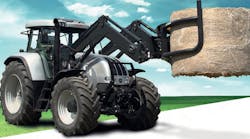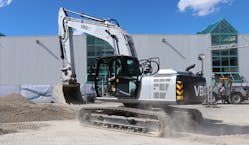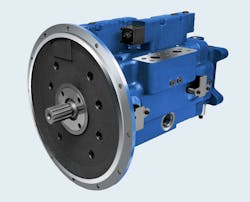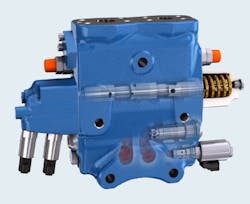The operation of mobile equipment usually requires compromise. In particular, hydraulic components are generally on fixed settings (e.g., the pressure setting of the pump), which cannot be managed and regulated in the field. Tractors present a prime example. They have to support a wide range of implements and their hydraulic systems are often set to levels that represent the best compromise for most circumstances. As a result, these implements are not always working at optimal performance, speed, and energy efficiency.
For example, systems with fixed-displacement pumps always undergo high pressure drops—that is, the excess pressure needed to compensate for resistance in the system oil flow. When actual oil consumption is low, these high pressure drops waste energy.
Advancing Technology
E-Load sensing (e-LS) aims to tackle such issues by introducing not only flexibility but the possibility of intelligence to tractor hydraulics. The system we’ve created brings together discretely designed SBx4 valves, SENT pressure sensors, an electronic RC control unit and an electrically controlled, variable pump. Together they provide electronic closed-loop load sensing control, within which tractor manufacturers can define system parameters for individual attachments and work tasks.
Rexroth SBx4 valves meet these requirements with mechanically and electrically actuated sandwich valves that can be grouped together. Furthermore, the hydraulic ports are uniformly aligned in all variations. Compared to its previous version, the SBx3, SBx4’s flow rate has increased 170 l/min at an operating pressure of up to 220 bar (3,200 psi).
The SBx4 product family of directional-control valves and plates uses a modular, uniform flange configuration for almost any combination of control blocks in any valve section. due to the uniform flange.
The modular combination of valves with varying flow rates in one control block reduces required plumbing and provides every consumer with just the amount of hydraulic power it needs. Plus, designers can combine up to seven valve sections in one block and, therefore, control a wide range of tractor peripherals. The SBx4 series also includes matching hitch valves to cover the whole range from single- to double-acting systems with scalable additional functions. Maintenance is simplified because of the valves’ separately exchangeable electronics.
Manufacturers can also alter these parameters dynamically depending on operating requirements. For example, pressure settings can vary, extending the pressure cut-off for higher power of an attachment, or lowering the stand-by pressure to save energy. In the future, settings might be adjustable and monitored via an app on a Bluetooth device.
Then there’s the intelligence. When implements are connected to the e-LS auxiliary valves, the pressure sensors detect the load and inform the electronic control unit (ECU), which instructs the pump to recognize and meet the need of those attachments. The conventional hydraulic load sensing signals can also be processed: For example, the steering can be connected in the usual way via a hydraulic load sensing line, whereby the applicable safety regulations can continue to apply. This simplifies the integration of e-LS into existing systems.
Diagnostic and Maintenance Benefits
The technology can be used to optimize the system’s behavior. The sensors we use to gauge pressure can also be used to monitor temperature, providing alerts to anomalies such as high oscillation and allowing the system to take countermeasures. Pressure adjustments can be triggered to pre-empt breakdowns or damage.
The system can also gather data on levels of pressure, flow and temperature during operation, enabling fast, accurate, and cost-effective diagnosis of the system that can be interpreted either on-site or online via the cloud. This, too, can be used for preventative maintenance purposes to minimize downtime, as well as by manufacturers for the optimization of future machine-designs.
Virtual Bleed Off System Increases Excavator Efficiency
The virtual bleed off closed-center excavator system supports machine manufacturers in implementing measures for compliance with statutory regulations for exhaust and noise emissions.
With conventional hydraulic systems, more hydraulic fluid than actuators need to move a load is often pumped through the system. Newer technology, however, determines the quantity of oil needed via pressure sensors. Therefore, the pump supplies just enough flow that the hydraulic actuators need to move a load.
A hydraulic two-circuit, closed-center system plays a central role in Rexroth’s virtual bleed off (VBO) system. VBO software and an electrically pressure-controlled pump electronically (virtually) reproduce the conventional open-center system and its inherent load sensitivity—an important feature for operators. The electrically pressure-controlled pump can safeguard maximum system pressure and individual consumer pressure without losses by using variable pressure cut-off.
Virtual bleed off technology, first introduced by for excavators by Rexroth in 2009, is a closed-center system in which losses—which otherwise would occur in the neutral line—are eliminated. At the same time, the excavator operator still has the benefit of load sensitivity inherent to open-center systems. This second-generation VBO system offers three key components:
- a Rexroth A28VO variable-displacement double pump,
- an RCS main control valve, and
- an RC electrical control unit with second-generation VBO software.
Double Pump with Compact Design
Maximum permissible exhaust emissions repeatedly become tighter around the world and often require excavator manufacturers incorporate elaborate exhaust gas after-treatment and additional components. As a result, installation (especially under the hood) is becoming more and more scarce. Rexroth developed its A28VO variable double pump, the most compact tandem pump in its class. It is a variable double pump in swashplate design, with significantly increased dynamics and accuracy, thanks to optimized actuating forces on the pump controller and on the adjustment system.
With an installation length of only 440 mm, the size 130 Rexroth A28VO double pump is about 20% shorter than conventional hydraulic pumps. It is also said to have 3 to 5% greater overall efficiency and a 20-bar higher nominal and maximum pressure.
Configurable for each function—The new RCS main control valve is a closed-center design that can be installed both vertically and horizontally. The RCS concept is based on two parallel, independent pump channels with low pressure losses. The functional axes can be configured in terms of their quantity, sequence, and size to fulfill the required function. The RCS valve platform is available in three nominal sizes and can be used for excavators weighing from about 20 to 400 tons.
The second-generation VBO uses a modular valve kit that can be adjusted individually to the task in the field. Moreover, it is possible to configure relief valves, anti-drift valves, Rexroth eValves or load- holding valves, plugs, and hydraulic or electrohydraulic control covers for each functional axis.
Combined with the Virtual Bleed Off software, the RCS control block platform offers flexible and energy-efficient control for crawler, wheeled, and mining excavators and similar heavy-duty machines. Shown hear is an RCS boom-control module.
Modular software concept—second-generation VBO open software architecture uses modules and flexibility for selection of the control units. This basis offers the option to freely program the flow distribution to the various consumers in order to meet the requirements of the end-user with utmost precision. Therefore, modular and individually customizable software packages are made available. Designers can choose between the complete VBO software package or a modular software kit.
Simplified commissioning, diagnosis, and maintenance—Simplified system architecture can eliminate numerous hydraulic lines, which reduces installation time and expense. It can also simplify troubleshooting and maintenance in the field.
Compared to electrical positive control, the energy-efficiency (filled excavator buckets per liter of fuel consumed) with VBO is improved by more than 10%. Its modular hardware and software structure make second-generation virtual bleed upgradeable for future requirements, starting with the electrification and hybridization of assistance systems, automated movement control, on to the autonomous work execution.
Uwe Maier is sector manager—tractors, and Benjamin Wogrin is industry sector manager—excavators, both at Bosch Rexroth GmbH. For more information on 2nd-generation virtual bleed off, click here.






